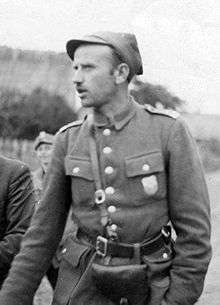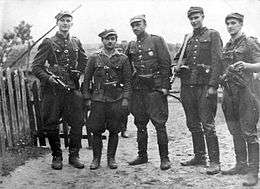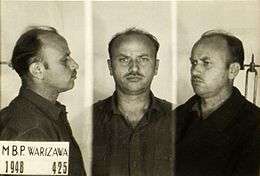Zygmunt Szendzielarz
| Zygmunt Szendzielarz | |
|---|---|
 Rotmistrz Szendzielarz before 1948 | |
| Nickname(s) | Zagończyk, Łupaszka |
| Born |
12 March 1910 Stryj, Austrian Partition |
| Died |
8 February 1951 Mokotów Prison |
| Awards |
|
Zygmunt Szendzielarz (12 March 1910 – 8 February 1951) was the commander of the Polish 5th Wilno Brigade of the Home Army (Armia Krajowa), nom de guerre "Zagończyk" or "Łupaszka".[1] He was executed in the notorious Mokotów Prison as one of anti-communist so-called Cursed soldiers following the Soviet takeover of Poland at the end of World War II.
Life
Szendzielarz was born in Stryj (Austrian Partition, now Lviv Oblast, Ukraine), then part of the Austro-Hungarian Empire and from 1919 to 1939 in Poland, into the family of a railway worker. After graduating from primary school in Lwów, he attended a biological-mathematical gymnasium in Lwów and then Stryj. After graduating, he volunteered for the Polish Army and completed Infantry Non-commissioned officer School in Ostrów Mazowiecka (1932), then Cavalry NCO School in Grudziądz. He was promoted to lieutenant and transferred to Wilno, where he assumed command of a squadron in the 4th Uhlan Regiment.
World War II
With his unit he took part in the 1939 September Campaign. His unit was attached to the Wilno Cavalry Brigade under General Władysław Anders, part of the Prusy Army. After retreating from northern Poland, the forces of Gen. Anders fought their way towards the city of Lwów and the Romanian Bridgehead. However, in the area of Lublin Szendzielarz's unit was surrounded and suffered heavy losses. Soon afterwards Szendzielarz was taken prisoner of war by the Soviets, but he managed to escape to Lwów, where he lived for a short period under a false name. He tried to cross the Hungarian border to escape from Poland and reach the Polish Army being formed in France, but failed and finally moved with his family to Wilno.
In Wilno, Szendzielarz started working on various posts under false names. In mid-1943 he joined the Home Army under the nom de guerre Łupaszka, after Jerzy Dąbrowski,[2] and in August he started organizing his own partisan group in the forests surrounding the city. Soon the unit was joined by local volunteers and the remnants of a unit of Antoni Burzyński ("Kmicic"), destroyed by Soviet Partisans and the Wehrmacht. By September, the unit was 700 men strong and was officially named the V Vilnian Home Army Brigade (V Wileńska Brygada Armii Krajowej).

Łupaszko's unit fought against the German army and SS units in the area of southern Wilno Voivodeship, but was also frequently attacked by the Soviet Partisans paradropped in the area by the Red Army. In April 1944, Zygmunt Szendzielarz was arrested by the Lithuanian police and handed over to the Gestapo. Łupaszko was free in the same month under circumstances that remain unclear. In reprisal actions his brigade captured several dozen German officials and sent several threatening letters to Gestapo but it remains unknown if and how these contributed to his release.
Operation Ostra Brama
In August, the commander of all Home Army units in the Wilno area, Gen. Aleksander "Wilk" Krzyżanowski, ordered all six brigades under his command to prepare for Operation Tempest — a planned all-national rising against the German forces occupying Poland. In what became known as Operation Ostra Brama, Brigade V was to attack the Wilno suburb of Zwierzyniec in cooperation with advancing units of the 3rd Belorussian Front. However, Łupaszko, for fear of being arrested with his units by the NKVD and killed on the spot, disobeyed orders and moved his unit to central Poland. Wilno was liberated by Polish and Soviet forces, and the Polish commander was then arrested by the Soviets and the majority of his men were sent to Gulags and sites of detention in the Soviet Union.[3]
It is uncertain why Szendzielarz was not court-martialed for desertion. Most likely it was in fact General "Wilk" himself who ordered Łupaszko's unit away the Wilno area, due to Łupaszko long having been involved in fighting with Soviet partisans and Wilk not wanting to provoke the Red Army. Regardless, after crossing into the Podlasie and Białystok area in October, the brigade continued the struggle against withdrawing Germans in the ranks of the Białystok Home Army Area. After the region was overrun by the Soviets, Łupaszko's unit remained in the forests and he decided to await the outcome of Russo-Polish talks held by the Polish Government in Exile. Meanwhile, the unit was reorganized and captured enough equipment to fully arm 600 men with machine guns and machine pistols.[4]
After World War II

After the governments of the United Kingdom and United States broke the pacts with Poland and accepted the communist "Polish Committee of National Liberation" as the provisional government of Poland, Łupaszka restarted hostilities—this time against the new oppressor, in the ranks of Wolność i Niezawisłość organization. However, after several successful actions against the NKVD units in the area of Białowieża Forest, it became apparent that such actions would result in a total destruction of his unit.
In September 1945, Zygmunt Szendzielarz moved with a large part of his unit to Gdańsk-Oliwa, where he remained underground while preparing his unit for a new partisan offensive against the Soviet-backed communist authorities of Poland. On April 14, 1946, Szendzielarz finally mobilized his unit and headed for the Tuchola Forest, where he started operations against the forces of the Internal Security Corps, Urząd Bezpieczeństwa and the communist authorities. Łupaszko was hoping that in the spring of 1946 the former Western Allies of Poland would start a new war against the Soviet Union and that the Polish underground units could prove useful in liberating Poland. However, when he realized that no such war was planned he decided to disband his unit. He saw further fight as a waste of blood of his men and decided to retire from open fight against the communists.
After several years underground, he was arrested by the UB on June 28, 1948, in Osielec near Nowy Targ. After more than two years of brutal interrogation and torture in Warsaw's Mokotów Prison he was sentenced to death on November 2, 1950 by the Soviet-controlled court martial in Warsaw. He was executed on February 8, 1951, together with several other Home Army soldiers. Szendzielarz was 40 years old. His body was buried in an undisclosed location. During a 2013 exhumation Szendzielarz's remains were recovered and identified as one of roughly 250 bodies buried in a mass grave at the so-called Meadow at Warsaw's Powązki Military Cemetery.[5]
Posthumous history
After Łupaszko's death, communist propaganda accused him of all sorts of purported crimes, from the crimes against humanity to robbery and common theft. In 1988 Szendzielarz was posthumously promoted to rotmistrz and awarded the Virtuti Militari, Poland's highest military decoration, by Kazimierz Sabbat, the President of Poland in exile.[4]
After the fall of communism, in 1993, Szendzielarz was rehabilitated and declared innocent of all charges.[1] On 2007 Polish president Lech Kaczyński posthumously awarded Szendzielarz with the order of Polonia Restituta.[6]
Honours and awards
- Virtuti Militari, V class; for participation in the September 1939 campaign
- Cross of Valour (January 1944)
- Gold Cross, Virtuti Militari (June 25, 1988) in recognition of outstanding deeds during the war
- Grand Cross of the Order of Polonia Restituta, awarded by Polish President Lech Kaczynski, November 11, 2007
See also
References
- 1 2 IPN (11 June 2003). "Przeglad Mediow: Wystawa IPN w Białymstoku". Białystok: Institute of National Remembrance.
- ↑ "Łupaszka – the cursed soldier", Pangea Magazine, June 8, 2014
- ↑ Andrzej Kaczyński (2 October 2004). "Wielkie polowanie: Prześladowania akowców w Polsce Ludowej" [Great hunt: the persecutions of AK soldiers in the People's Republic of Poland] (Nr 232). Rzeczpospolita – via Internet Archive.
- 1 2 Emilian Waluchowski (8 June 2014). "Łupaszka – the cursed soldier". Major Zygmunt Szendzielarz. Pangea Magazine.
- ↑ Tomasz Leszkowicz (2013). "IPN ujawnia wyniki identyfikacji kolejnych ofiar UB. Wśród nich m.in. "Zapora" i "Łupaszka"". HistMag (in Polish) (2013-08-22).
- ↑ "Prezydent odznaczył "żołnierzy wyklętych"". Archived from the original on November 13, 2007. Retrieved November 13, 2007. 11.11.2007
- Kozłowski, Patryk (2004). Jeden z wyklętych. Zygmunt Szendzielarz "Łupaszko" (in Polish). Warszawa: Rytm. ISBN 83-7399-073-9.